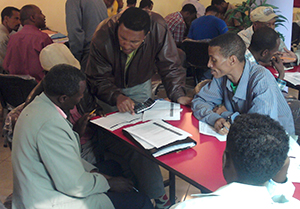To improve annual district-level antimalarial commodity quantifications, PMI partnered with the Oromia Regional Health Bureau and UNICEF to hold micro-planning meetings.

District officials during a micro-planning meeting in Adama, Ethiopia. Source: Dereje Muluneh, UNICEF/Ethiopia
Accurately quantifying antimalarial commodity requirements in Ethiopia is a challenge for multiple reasons. Transmission of malaria is highly variable and characterized by frequent and often large-scale epidemics. In addition, both artemisinin-based combination therapy (ACT) and rapid diagnostic tests (RDTs) have a short shelf life. At the district level, poor quantification has often resulted in either an over-supply of antimalarial drugs and diagnostic kits and their subsequent expiry, or shortages and stockouts of these commodities.
To improve annual district-level antimalarial commodity quantifications, PMI partnered with the Oromia Regional Health Bureau and UNICEF to hold micro-planning meetings. To determine ACT, chloroquine, and RDT requirements, each health facility used morbidity data from the previous year. For quantification of long-lasting insecticide-treated mosquito nets (LLINs), a number of data points were considered, including: population by village, number of LLINs needed, number of LLINs distributed during the past three years, and LLIN gap to achieve universal coverage in 2012. Data from these meetings were then compiled and a standard data collection format was presented to partners for revision and approval.
Micro-planning meetings have been held in the Oromia Region for the last three years, and have proved useful in guiding the procurement of antimalarial commodities (including ACTs, chloroquine, RDTs, and LLINs). Of note, these meetings have generated more precise estimates of needed ACTs. For example, prior to micro-planning, the estimated need for ACTs in 2011 was 3.37 million treatments. With micro-planning, assuming that 80% of cases are confirmed with laboratory diagnosis, the need was revised downward to only 1.24 million treatments. These more refined estimates have enabled the Oromia Regional Health Bureau to more efficiently distribute commodities to districts, and do away with the previous top-down approach that used estimates with larger error margins.
During 2011, at the request of Federal Ministry of Health, micro-planning was expanded to the additional eight regional states in Ethiopia with support from PMI, UNICEF, and other Roll Back Malaria partners. Fourteen micro-plan meetings were conducted to cover all districts that are at risk for malaria nationwide. In addition to generating quantifications for commodities, each meeting also provided an opportunity to review the malaria program and enable the Ministry of Health and partners to obtain accurate, district-level data on key coverage indicators that will inform future prevention and control activities.
During 2011, at the request of Federal Ministry of Health, micro-planning was expanded to the additional eight regional states in Ethiopia with support from PMI, UNICEF, and other Roll Back Malaria partners. Fourteen micro-plan meetings were conducted to cover all districts that are at risk for malaria nationwide. In addition to generating quantifications for commodities, each meeting also provided an opportunity to review the malaria program and enable the Ministry of Health and partners to obtain accurate, district-level data on key coverage indicators that will inform future prevention and control activities.
